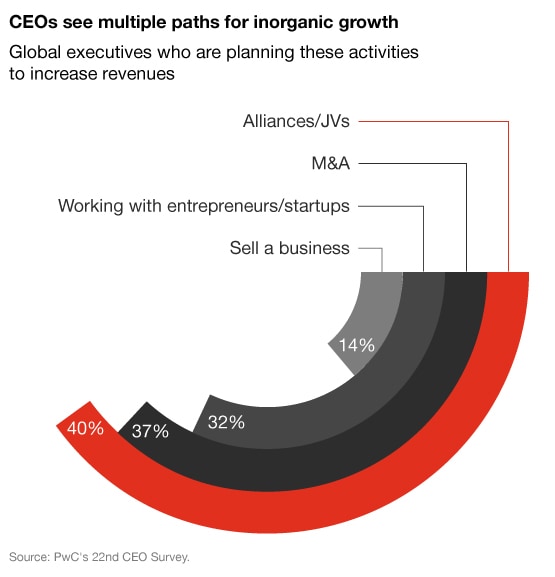Elevating the deal discussion
With few exceptions, companies depend on growth for survival and success. That can happen naturally through expanding the customer base or introducing new products and services. But getting ahead often means inorganic growth – that which comes through other actions, usually deliberate and sometimes dramatic. This may be a response to disruption or a proactive step to advance a company’s strategy. Whatever the reason, choosing the right mechanism for growth is crucial.
Among the most common paths for inorganic growth are mergers and acquisitions (M&A) and strategic partnerships, such as alliances and joint ventures (JVs). These types of deals have become more important as industries continue to evolve and the lines between some of them blur. Such shifts can make previous paths for organic growth obsolete. Consider the entertainment industry and how movies are watched now compared with 10, 25 or 50 years ago. Or the US airline industry, which now has only a dozen large carriers, with four controlling about 80% of the market. Faced with different types of disruptions – technological, demographic, geopolitical – companies must keep their growth options open.


Similar goals, different advantages
Acquisitions and alliances can achieve similar goals. Both allow a company to expand its reach – through access to new products or services, new geographic or industry markets, or new types of customers. Both can open the door to additional or new resources, such as technology and talent. Both typically require a significant investment of financial capital, time commitment and executive oversight.
While both deal types can drive business growth, deciding whether to buy or partner with another company can be daunting. Each brings its own challenges along with the benefits, and choosing wrong can leave a business chasing competition, mired in financial straits or struggling in other ways. CEOs, company owners and other leaders can’t afford those missteps.
That’s why it’s essential for businesses pursuing growth to understand the key considerations in determining if an acquisition or an alliance is the best path for inorganic growth. These include important questions and distinctions about capabilities, control, cost and conditions beyond a company’s control. Companies also need to recognize the role of divestitures in their growth decisions, as well as situations in which M&A and partnerships both could make sense.
When deciding on an acquisition or alliance
- Capabilities: Filling a gap or building on strengths
- Control: Weighing investment, access and ownership
- Cost: Determining the business ROI
- Conditions beyond control: Predicting success based on external factors
- Keeping the right pieces: The role of divestitures
- Best of both worlds: When a partnership + M&A makes sense
Capabilities: Filling a gap or building on strengths
Many deals are made to improve a company’s capabilities or its portfolio of products and/or services.
Enhancement can be one goal – filling a capabilities gap or responding to a change in the market.
- An acquisition could open up all of a target company’s capabilities – including some the acquirer may not want – and be the only way to access core capabilities. An acquisition also allows longer-term access and the ability to integrate and maintain capabilities. That could improve the potential for more value from the deal.
- With a partnership, a company can pursue new capabilities to benefit specific parts of the existing operations or portfolio. An example is gaining access to a new region or market that may be narrow enough that the company doesn’t want to integrate the entire target. Another scenario is a company’s inability to handle an integration but desire to maintain an ongoing relationship.
Or a company may want to leverage existing capabilities – building on strengths with another company’s products and services.
- M&A makes sense if all or most of the target’s products and services can benefit from the acquirer’s capabilities. Those that don’t fit could be candidates for divestiture.
- An alliance may be preferable if the target’s products and services don’t provide independent value when combined with the acquirer’s capabilities system. In this situation, the target’s products and services could be bundled with the acquirer’s products and services.
Next steps
When organic growth isn’t enough, companies need to decide which deals will generate value and move their businesses forward. An effective growth strategy recognizes that M&A and partnerships both can drive expansion. Determining which transaction is best for certain situations is critical for an optimal return on investment.
C-suite executives, corporate development teams and other dealmakers can navigate the question of acquisition or alliance by gaining more insight on key considerations for inorganic growth. Capabilities, control, cost and conditions beyond a company’s control all play important roles in deciding on the deal type.
Organizations that don’t have a firm grasp on these aspects of a deal should seek that expertise and incorporate it into their inorganic growth discussions. By improving their understanding of the advantages and challenges of M&A and partnerships, companies can make better decisions on deals that deliver higher value.








